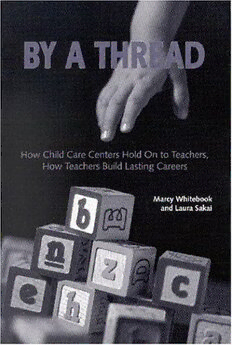
By a Thread: How Child Care Centers Hold on to Teachers, How Teachers Build Lasting Careers PDF
159 Pages·2003·0.381 MB·English
Most books are stored in the elastic cloud where traffic is expensive. For this reason, we have a limit on daily download.
Preview By a Thread: How Child Care Centers Hold on to Teachers, How Teachers Build Lasting Careers
Description:
Whitebook and Sakai examine how child care programs and their staff subsist in a field characterized by low pay, low status, and high turnover, and what the impacts of these factors are on the quality of child care provided. Their study is based on an in-depth survey of 75 mid-size, relatively high-quality child care centers located in an economically thriving region. They collect data on salaries, training, and educational background for all teaching staff employed at the centers at three points in time—1994, 1996, and 2000. These data provide a detailed picture of the entire teaching workforce at the 75 centers in 2000 and allow a comparison of the workforce in that year to those in 1994 and 1996. This inside look paints a disturbing picture of a dedicated yet poorly paid, high-turnover workforce. Part I of the book focuses on staff departures and center quality. In it, Whitebook and Sakai relate the types and magnitude of turnover occurring among teachers at child care centers to the level of quality provided there. They present empirical evidence on the correlation between center quality and staff stability as well as the perspectives of teachers and directors in their survey who reflect on the challenge of attaining and maintaining high-quality care. In Part II, Whitebook and Sakai rely on in-depth, quantitative evidence to examine the experience of child care employment. They point out interesting relationships between the characteristics of the child care workforce and those who have chosen to leave, stay, or join on. They then discuss work and family decisions that impact child care workers' career decisions, including the rewards listed by workers as reasons they remain employed in child care. The authors conclude with three policy recommendations that echo the suggestions made to them by the teaching staff and directors interviewed in their survey.
See more
The list of books you might like
Most books are stored in the elastic cloud where traffic is expensive. For this reason, we have a limit on daily download.
